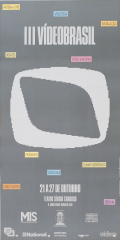- Fotoptica
- Museu da Imagem e do Som (São Paulo)
- Secretaria de Estado da Cultura de São Paulo
At the time of the third edition of the Festival, held at Sérgio Cardoso Theater, video was gaining space in Brazil. Independent productions were gaining ground on TV: production company Olhar Eletrônico was selling its work to shows aired on prime time on Rede Globo, and channels like Cultura, Bandeirantes and Gazeta were also opening their programming to the new generations.
Paying attention to this context, the Festival featured three major thematic sections: the entry of video into TV, videotheater, and the spread of the growing national output domestically and abroad. The first signs of the new medium’s stabilization. The monopoly of open TV networks continued to permeate the debates, which considered alternatives such as UHF and cable TV.
The Competitive Exhibition highlighted an experiment with “channel-less” community TV by the TV Viva group, from Recife (Pernambuco), the grand prize winner in this edition, as well as works marked by experimentation with poetical language. The State Secretariat for Culture created the Stimulus Prize for video. The exhibition Odisseia dos Sons (Odyssey of Sounds) and a hologram exhibit explored the specific language of video. The Videobrasil Video Library, a collection that would later comprise thousands of titles, was born.
Visual identity and graphic design | Bill Martinez

Programme
competitive show
Competitive Show | 3rd Festival
This edition’s Competitive Show has strived to promote the development of electronic languages by publicizing video as a vehicle for contemporary expression. Out of 96 submissions in U-matic and VHS, 50 have been shortlisted.
film and/or video screenings
"Conexão Internacional", with Jorge Luís Borges
The Conexão Internacional (International Connection) TV show features an interview with the Argentinian writer Jorge Luís Borges, with editing by Intervídeo.
"Gay Pride Parade"
Gay Pride Parade documentary, by Cândido José Mendes Almeida and Hélio Alvarez, about the gay parade held annually in New York.
"Os Pioneiros"
The retrospective exhibition of video art pioneers in Brazil featured 35 works created between 1974 and 1980. Using heavy “portable” recorders, these pioneers researched the new medium exhaustively, discovering video’s own language.
Fernando Gabeira Show
A collection of video works by Fernando Gabeira, aired on TV Bandeirantes’ Sexta-Feira (Friday) show. Gabeira embarked on a quest for a suitable language for his political videos, approaching subjects like agrochemicals, Aids, atomic waste and homeless people.
Olhar Eletrônico Retrospective
An overview of the history of the Olhar Eletrônico Vídeo production company. The retrospective featured a video made especially for the Festival, comprising statements from the members themselves about their highlights.
exhibition
“A Arte na Trama Eletrônica”, by Rodolfo Cittadino
Exhibition produced by Rodolfo Cittadino, one of the pioneers in researching the art’s potential and development using teletext. The show featured works by five “grid artists” from various origins, including from Brazil, France and Portugal.
performance
Otavio Donasci
The Festival’s programming featured several presentations by Otavio Donasci, including a few video performances, such as the Videocriaturas, a video theater project, and a "videosymphony" conducted by the artist.
public programs
"Antena Livre" (1)
One of the Festival’s most important initiatives was its hosting of three days of debates with artists and the audience, to discuss the changes required for a right to information policy and the necessary modifications to the upcoming Constituent Assembly.
"Antena Livre" (2)
One of the Festival’s most important initiatives was its hosting of three days of debates with artists and the audience, to discuss the changes required for a right to information policy and the necessary modifications to the upcoming Constituent Assembly.
"Antena Livre" (3)
One of the Festival’s most important initiatives was its hosting of three days of debates with artists and the audience, to discuss the changes required for a right to information policy and the necessary modifications to the upcoming Constituent Assembly.